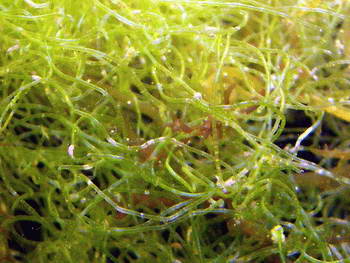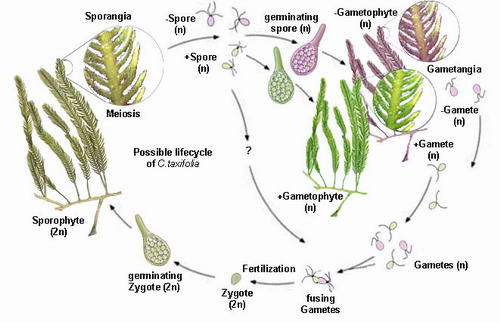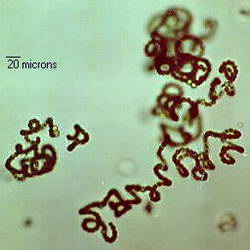This mirror is being hosted with the permissions of the original content creator for preservation and educational purposes.
 Presented by Charles & Linda Raabe
Presented by Charles & Linda Raabe
Mactan Island, The
Philippines
© 2008 All Right Reserved
While most hobbyists first encounters with algae is in dealing
with how to control or erradicate them from their aquariums, there are
also many of us who are now keeping many of the macro (large) algae
species as part of their system's landscape, of which only
increases the biodiversity of such systems and is a great help in
maintaining the balance between nutrient imports and exports.
Since it would be of higher interest to those trying to deal
with problems in algae control, I will try to provide the information
and links that I have found to be of use in this area first.
A check list of what you can do to deny problem algae and cyano bacteria the conditions they need to thrive.
1. First, understand that algae and cyano bacterias will always
be a part of your system, there is no way you will ever eradicate it
totaly. Having to clean an algae film from your aquarium's glass every
few days and keeping a few herbivores such as snails, is just part of
keeping any type of aquarium. But when algae dominates your system and
threatens to outcompete and smother your corals, action must be taken.
(A) We must also realize that a new setup is going to
take time for its biology to get established and for any controls to
take effect. Six months to a year is not an unreasonable amount
of time for a system to balance out. Remember, this is a hobby
that demands patience.
(B) The entire battle that is fought with any algae or
bacterial problems can be traced back to being an issue of nutrients.
2. Your freshwater sources : Starting out with and continuing to
use as pure a freshwater source as possible is probably the single best
thing that you can do to tip the odds in your favor. Tap water is
usualy loaded with impurities and nutrients that will fuel excessive
algae growth. As such, I believe that one of the first peices of
equipment that you should purchase is an RO/DI water filtration system, if that is not possible right away, then at least use distilled water when making up your saltwater.
3. Water changes : As an old saying goes within this hobby, "
the solution to pollution is dillution". Doing frequent large water
changes is, in my opinion, THE single best thing you can do for your
entire system. Not only are you removing (dilluting) out nutrients, you
are also removing a host of other elements that will build up in an
enclosed system while at the same time, bringing other much needed and
used elements back up to proper levels without having to become a
chemistry major and doing what I feel is the single biggest mistake
made in this hobby, which is adding additives and supplements.
4. Limit the nutrients you add to the tank : Everything you feed
the tank wether its "bad" water, supplements or fish/coral food will
add to the importation of nutrients, which will then be used by algae.
(A) Limit or stop using flake or pelleted foods which
contain high levels of phosphates and other excessive nutrients. Frozen
prepared foods or fresh seafoods are a much better choice.
(B) Do not add Iodine supplementation. The only "fact"
that has been proven is that algae consumes and holds a great quantity
of this element. All of the claims of invertebrates or corals needing
amounts greater than found in natural sea water are ancedotal and have
yet to be proven. If you want alot of algae, add Iodine.
5. Examine your stocking levels of fish. Quite often an aquarium
will be overstocked with fish that the system's biology can not deal
with. Fish being the greatest source of nutrient importation by their
just being alive and our having to feed them.
6. If you can not beat them, then join them : Using algae itself
to uptake and lock up nutrients is a highly effective and much more
natural method of nutrient control. Having a sump compartment or
another tank used to cultivate algae which can then be trimmed and
thrown away will help to deny those algae in the show tank the
nutrients they need to grow.
7. Use herbivores such as snails to consume that algae which will grow within the show tank.
The Links
The following links will be of use and interest regarding algae and cyanobacteria control.
Reef Aquria as Ecosystems - "Discussing
marine reef aquaria as ecosystems and how we should manage them using
an ecosystem or holistic approach, as opposed to the micromanagement
philosophy that seems inherent in most reef aquarium husbandry."
The types of algae in marine aquria - "Pond
scum, kelp, red tides, seaweed and "that film on the glass". These are
but a few of the many names that are used to describe the algae. These
are the plants of the sea. It is a huge assemblage of organisms with
species numbering in the tens of thousands."
Algae Control Tips - "A selection of useful tidbits of information and tricks for the marine aquarist submitted by Advanced Aquarist's readership"
Nuisance Algae in the Reef Aquarium
- "In this series of articles I will explain the different types of
fuel that allow these unsightly algae to take over an aquarium."
Clean up Crews - "What I intend for this article is to give some general ideas to the various
"clean-up crew" participants that are available and their usefulness to the marine aquarium."
Use of Mangroves - "Mangroves have become increasingly familiar additions to marine displays and refugia"
Dinoflagellates - "Many dinoflagellates are photosynthetic and are among the major primary producers of the phytoplankton along with diatoms."
Diatoms & Silica - "Silica
is a chemical that is feared by many reef keepers. Visions of a reef
tank covered with diatoms so thick that you can not see through the
glass come to mind."
Cyanobacteria webserver - "Cyanosite is dedicated to the information transfer within the cyanobacterial research community"
The Macroalgae
A species of Chaetomorpha, fast growing and excellent for nutrient exporting.
In our battle with the micro or nuisance algae, you will find
many references to using macro (large) algae as a means to export
nutrients that fuel the algae types that we need to control. What is
usualy over looked is the fact that many of the larger algae are quite
pleasant to look at and provide a much more natural landscape, such can
be said of the sea grasses as well. The following links will relate to their identification and care tips.
Caulerpa Algae
- It is quite common within the hobby to use any number of
Caulerpa algae species as a means to control nutrient levels within our
reef aquariums. Given that this group of algae only do well with
higher nutrient levels than what we strive to maintain within our
systems, I would only recommend their use for those aquariums that
constantly struggle with higher than normal nutrient levels. There are
a few dangers or concerns to be aware of if this algae group is kept.
-
Caulerpa species are fast growers, and do so with strong holdfasts that
anchor the algae to the substrates making them difficult to remove.
Even with their removal, any remaining holdfasts on the substrate can
regenerate and make these species difficult to be rid of once
established. If you do wish to keep these alage, I would do so
outside of the main display aquarium within a refugium.
-
With the fast growth, comes faster nutrient uptake, which is what
we would want when struggling with water quality issues brought on by
excessive nutrients. The problem with the use of these species is that
they are found in the wild only in near shore areas that contain higher
nutrient levels than that found out on the coral reef. When the
nutrient levels fall, the algae will suffer and most likely go into
sporalation (method of reproduction), This is characterized by the
algae becoming translucent and disintegrating, this can happen very
quickly. When it does happen, if enough of the algae is present it can
foul the water and result in mass die off. As such, I would only
use these species temporarily to get excessive nutrients under control
(water changes would be more effective) and then switch to other macro
algae species of which the majority of them require lower nutrient
levels to live in than the caulerpa species.
- Caulerpa species also contains a toxin called caulerpenyne which makes it undesireable to most
herbivores, the toxin is also released anytime the algae is broken and possibly
just leached from the algae as it grows. The toxin can over long term exposure
or with high amounts have deleterious effects on inverts and fish. The toxin can
be removed with the use of activated carbon, and I would suggest if you intend
to keep the caulerpa then you should use activated carbon somewhere in the
system.
As you can see, the use of any of the Caulerpa algae would most
likely not be a good idea as there are better and safer alternatives to
bringing high nutrient levels under control in my opinion. If you do
keep these algae, I would be aware that as your aquarium's nutrient
levels start to fall, you risk having it suddenely die off. Not a good
thing to have happen.
Algae in the coral reef envrionment - "Competition for space with other attached organisms is one of the main factors controlling growth of the marine flora."
Beyond the Refugium, A macroalgae primer - "This series will focus on algal marine plants and attempt to highlight their more desirable and beautiful attributes."
A Planted Aquarium - "Seagrasses,
until recently, had earned only an obscure place in marine aquaria as
occasional, short lived accents in full blown reef tanks or as nutrient
export plants in refugiums."
Macroalgae for landscaping - "A very well put together guide"
The SeaPlants Handbook - A very comprehensive site and a great resource for algae identification.
Algae Identification - "This is basically a "visual" page where photos of different forms of algae and possible biological control critters can be seen."
Calurpa Sporulation - "I'm
sure most hobbyists that have kept Caulerpa in their refugium or
display tank know about or have experienced this algae's reproductive
activity."
Life Cycle of Caulerpa taxifolia
The Bacteria
Since life on this planet would not be possible without them,
including within our aquariums, I feel that we should take some time to
get to know at least a few of the bacterial families that are of
concern to our aquarium's biology. Knowing what certain strains need
provides us with the knowledge on how to either control them, or
promote them.
Bacterial Diversity Study Guide - Get to know our friends and our enemies.
Bacteria - Wikipedia's very informative article and the source of the following information.
CyanoBacteria Link #2 Link #3 - "Though cyanobacteria do not have a great diversity of form, and though they
are microscopic, they are rich in chemical diversity."
A note on the "red slime removers" - Being that
the cyanobacteria are just that, bacteria. Such products use an
antibacterial medication to kill off the cyanobacteria.
To me, this should only be done as a last resort and not something to
rely upon on a regular basis. If the problem is so great that all your
efforts to be rid of it fails, then I would consider killing it not
with any of the products available, but by simply using the main
ingredient those products contain, which is listed below. Of course
such treatment should only be done when the cyanobacteria's food
source(s) are limited and controlled.
Such products usualy contain either Erythormycin (white in coloration) or Tetracycline
(yellow in coloration). Also note that the product "ChemiClean" contains Erythromycin.
Most bacteria may be placed into one of three groups based on their response
to gaseous oxygen. Aerobic bacteria thrive in the presence of oxygen and
require it for their continued growth and existence. Other bacteria are
anaerobic, and cannot tolerate gaseous oxygen, such as those bacteria
which live in deep underwater sediments. The third group are the facultative anaerobes, which prefer growing in the presence of oxygen, but can continue to grow without it.
Bacteria may also be classified both by the mode by which they obtain their
energy. Classified by the source of their energy, bacteria fall into two
categories: heterotrophs and autotrophs. Heterotrophs derive energy from
breaking down complex organic compounds that they must take in from the
environment -- this includes saprobic bacteria found in decaying material, as
well as those that rely on fermentation or respiration.
The other group, the autotrophs, fix carbon dioxide to make their own
food source; this may be fueled by light energy (photoautotrophic), or by
oxidation of nitrogen, sulfur, or other elements (chemoautotrophic).
While chemoautotrophs are uncommon, photoautotrophs are common and quite
diverse. They include the cyanobacteria, green sulfur bacteria, purple sulfur
bacteria, and purple nonsulfur bacteria. The sulfur bacteria are particularly
interesting, since they use hydrogen sulfide as hydrogen donor, instead of water
like most other photosynthetic organisms, including cyanobacteria.
How Bacteria Eat: Like all living organisms bacteria
need to eat in order to live, grow and reproduce. However, bacteria are
far too small to have a mouth. Instead they have special channels in
their cell walls and cell membranes which allow, or even assist some
molecules to cross. Once the molecules are inside the cell they can be
broken down into their componant parts before being rebuilt into the
macromoloecules the bacteria needs in order to build and repair itself,
or generate energy.
Unfortunately for the bacteria the surrounding environment is
not always full of free-floating molecules of the correct sort.
Instead, the molecules may be all bound together. To solve this problem
bacteria have evolved the habit of leaking enzymes out into the
environment around them. These enzymes then do what ever it is they do,
attack specific tissues and molecules (proteases attack proteins,
cellulases attack cellulose etc) and break them up into smaller units.
Eventually molecules of a size that the bacteria can take into itself
are made that the cell can then absorb through the channels mentioned
above.
Bacterial metabolism is classified on the basis of three major criteria: the
kind of energy used for growth, the source of carbon, and the electron donors used for
growth. An additional criterion of respiratory microorganisms are the electron acceptors
used for aerobic or anaerobic respiration.
Cellular respiration describes the metabolism reactions
and processes that take place in a cell to obtain biochemical energy
from fuel molecules and the release of the cells' waste products.
Energy is released by the oxidation of fuel molecules and is stored as
"high-energy" carriers. The reactions involved in respiration are
catabolic reactions in metabolism.
Fuel molecules commonly used by cells in respiration include
glucose, amino acids and fatty acids, and a common oxidizing agent
(electron acceptor) is molecular oxygen (O2).
There are organisms, however, that can respire using other organic
molecules as electron acceptors instead of oxygen. Organisms that use
oxygen as a final electron acceptor in respiration are described as
aerobic, while those that do not are referred to as anaerobic.
The energy released in respiration is used to synthesize
molecules that act as a chemical storage of this energy. One of the
most widely used compounds in a cell is adenosine triphosphate (ATP)
and its stored chemical energy can be used for many processes requiring
energy, including biosynthesis, locomotion or transportation of
molecules across cell membranes. Because of its ubiquitous nature, ATP
is also known as the "universal energy currency", since the amount of
it in a cell indicates how much energy is available for
energy-consuming processes.
Nitrification is the biological oxidation
of ammonia with oxygen into nitrite followed by the oxidation of these
nitrites into nitrates. Nitrification is an important step in the
nitrogen cycle in water. The oxidation of ammonia into nitrite, and the
subsequent oxidation to nitrate is performed by two different bacteria
(nitrifying bacteria). The first step is done by bacteria of the genus Nitrosomonas and Nitrosococcus. The second step (oxidation of nitrite into nitrate) is done by bacteria of the genus Nitrobacter, with both steps producing energy
to be coupled to ATP synthesis.
Denitrification is the process of
reducing
nitrate and nitrite, highly oxidised forms of nitrogen available for
consumption by many groups of organisms, into gaseous nitrogen, which
is far less accessible to life forms. Denitrification takes place
under special conditions in marine ecosystems. In general, it occurs
when oxygen (which is a more favourable electron acceptor) is depleted,
and bacteria turn to nitrate in order to respire organic matter.
Because our water is rich with oxygen, denitrification only takes place
in areas such as our sandbeds where oxygen is very limited.
Denitrification proceeds through some combination of the following steps:
nitrate → nitrite → nitric oxide → nitrous oxide → dinitrogen gas
CyanoBacteria
Please take a moment and consider supporting any one of the projects listed within. Thank you.
This mirror is being hosted with the permissions of the original content creator for preservation and educational purposes.






